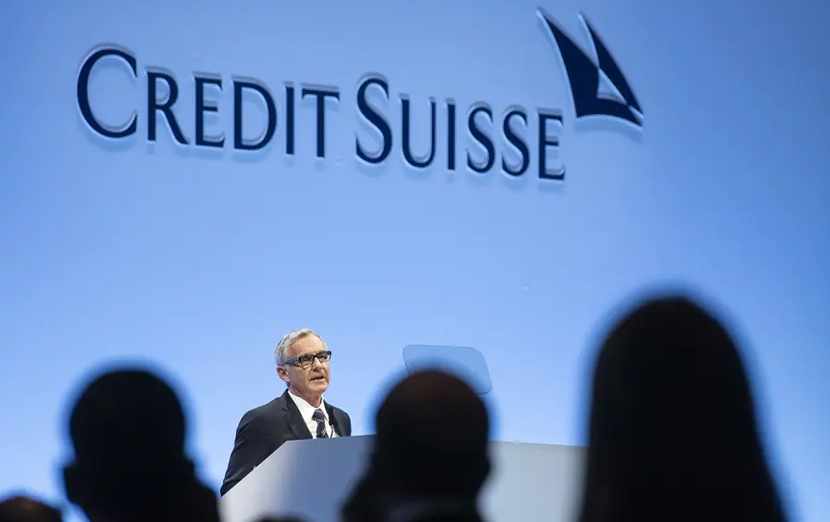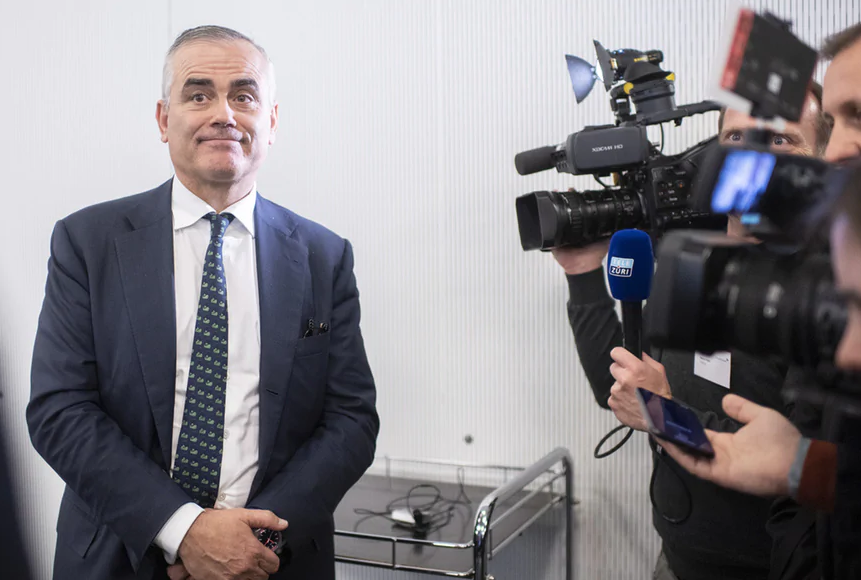Credit Suisse chairman Urs Rohner has some explaining to do at the bank’s AGM later this month. © Keystone / Ennio Leanza Five months before Greensill Capital’s collapse, Credit Suisse invited a special guest to present to its top ranks in Asia. The visitor was hailed as the sort of bold entrepreneur the bank wanted to do business with: Lex Greensill. “The tone was this is the exact kind of client the bank wants, tell the MDs to go out and find more guys like Lex,” said one senior manager who watched the November video conference. It was hosted by Helman Sitohang, the bank’s head of Asia and one of Greensill’s biggest advocates. Yet just two months earlier Greensill Capital had been put on a “watchlist” by the Swiss bank’s risk managers in Asia, according to
Topics:
Swissinfo considers the following as important: 3.) Swissinfo Business and Economy, 3) Swiss Markets and News, Business, Featured, newsletter
This could be interesting, too:
Nachrichten Ticker - www.finanzen.ch writes Die Performance der Kryptowährungen in KW 9: Das hat sich bei Bitcoin, Ether & Co. getan
Nachrichten Ticker - www.finanzen.ch writes Wer verbirgt sich hinter der Ethereum-Technologie?
Martin Hartmann writes Eine Analyse nach den Lehren von Milton Friedman
Marc Chandler writes March 2025 Monthly

Credit Suisse chairman Urs Rohner has some explaining to do at the bank’s AGM later this month. © Keystone / Ennio Leanza
Five months before Greensill Capital’s collapse, Credit Suisse invited a special guest to present to its top ranks in Asia. The visitor was hailed as the sort of bold entrepreneur the bank wanted to do business with: Lex Greensill.
“The tone was this is the exact kind of client the bank wants, tell the MDs to go out and find more guys like Lex,” said one senior manager who watched the November video conference. It was hosted by Helman Sitohang, the bank’s head of Asia and one of Greensill’s biggest advocates.
Yet just two months earlier Greensill Capital had been put on a “watchlist” by the Swiss bank’s risk managers in Asia, according to people familiar with the matter.
That might have raised more alarm at Credit Suisse, which had $10bn funds stuffed with loans originated by Greensill. In its main business, Greensill paid suppliers to large corporate customers — early but at a small discount — and received the full amount later from the corporate client. The debt was packaged into the Swiss bank’s funds that were sold to outside investors.
However, warnings were repeatedly dismissed by the bank’s leadership in Zurich, London and Singapore. They continued to market the Greensill funds and even approved a $160m loan to the company, which was launched by its eponymous Australian founder in 2011.
In March Greensill collapsed into administration. Its fall from grace could cost Credit Suisse’s clients as much as $3bn.
“Lex’s video appearance showed that the whole risk culture was just ‘thanks for the heads-up but we beg to differ’,” said the manager who watched the November presentation. “When Lex came along, the bank couldn’t get enough of him.”
The Greensill blow-up is only one link in a long chain of risk management failures at Credit Suisse. Just weeks later, Archegos Capital, the family office of disgraced former hedge fund manager Bill Hwang, defaulted on a margin call, sparking chaos at banks that had lent him billions to magnify his positions. Credit Suisse is nursing the biggest losses of at least $4.7bn.
Credit Suisse shareholder payouts have been cancelled and bankers face big bonus cuts. The succession of crises have left investors and staff furious and demanding answers. How did executives become so enthusiastic about a small group of dubious clients? And why were those raising red flags ignored or marginalised?
“Accumulating giant exposures to single entities, especially low-grade ones, goes completely contrary to every principle of how to manage risk,” said Benedict Roth, a former risk supervisor at the Bank of England.
Swimming with sharks
In interviews with the Financial Times, six current and former Credit Suisse managers said the bank hollowed out risk expertise and trading acumen in favour of promoting salesmen and technocrats. Dissenting voices were suppressed, they said.
“There was a dulling of the senses,” said a former executive. “Credit Suisse was in the deep end swimming with the sharks, but doing it with a private banking mindset. They were always going to get destroyed.”
At the centre of the controversies was Lara Warner, the chief risk and compliance officer until she was ousted on April 6. A former Lehman Brothers equity analyst, she joined Credit Suisse in 2002 to cover the cable television and telecoms industries.
The Australian-US dual citizen rose to finance director of the investment bank, before ex-CEO Tidjane Thiam named her chief compliance and regulatory affairs officer in 2015.
Credit Suisse chair Urs Rohner and Thiam “came in with a mindset that you can appoint anyone clever into a job and they will be a success, even if they had no experience . . . [but] that was inappropriate for risk and compliance,” another executive said.
When Thiam stepped down over a spying scandal, his successor Thomas Gottstein added global risk oversight to Warner’s responsibilities. He did this to try to save on duplicated technology and operating costs in the two divisions, on which the bank spends about half a billion dollars a year, a person close to the CEO said.
Warner was keen that the bank’s global risk function should not be seen as an “academic ivory tower” that could “dismiss business out of hand”, according to a person close to the bank. She also wanted her department to be seen as a career destination rather than an administrative backwater.
Sense of fear
During her five-year tenure, Warner and other executives pushed for risk and compliance to be “more commercial” and “aligned” with the front office traders and dealmakers, multiple current and former staff told the FT.
She led by example. In October, Warner personally overruled risk managers who cautioned against giving Greensill a $160m bridge loan ahead of a private fundraising. The loan is now in default.
Warner also removed more than 20 senior managers from Credit Suisse’s risk department. Most swiftly found high-ranking jobs, including at UBS, Jefferies, Standard Chartered and the Hong Kong Stock Exchange.
Her predecessor — Joachim Oechslin, a Swiss national and career risk manager — was moved aside to become chief of staff for CEO Gottstein. He has now been reinstalled as interim chief risk officer.
“When you bring in a sense of fear into an organisation by removing so many people, the culture of the risk is not to say ‘no’ to the business any more,” said a person involved at the time.
Last year Warner ruffled more feathers by changing reporting lines. Some markets risk functions, which previously sat within an independent central risk team, were shifted to report to the head of front office technology.
While some other banks use this model, “from a control point of view this was a disaster” at Credit Suisse, according to one person who lobbied against the changes. “Risk lost its independence.”
Missed chances
Helman Sitohang, Credit Suisse’s head of Asia, is another key figure in the Greensill relationship. He has remained out of the spotlight so far.
An investment banker by background, Sitohang brought in some of the bank’s most lucrative clients in the region, including a string of Indonesian tycoons such as Rajawali’s Peter Sondakh. He also leads the lender’s relationship with SoftBank, the Japanese group behind the $100bn Vision Fund, a significant backer of Greensill.
“He is a salesman. He has a risk-agnostic approach to clients,” said a person who worked closely with him.
Sitohang spoke up for Greensill during a summer 2020 review ordered after the FT revealed SoftBank was using Credit Suisse’s Greensill-linked supply-chain finance funds to route hundreds of millions of dollars to struggling companies it owned.
“Helman was personally very supportive of Lex, telling us we couldn’t damage the relationship with him,” a colleague said.
Credit Suisse missed numerous opportunities to avert disaster. According to two people close to the project, in 2016 the Asia business started to build a tool to map a client’s exposures in search for second-order problems that could rebound on the bank.
Called “Risk 360”, the tool was commissioned after the lender discovered outsized exposure to a group of businesses in Hong Kong that had links back to one individual, disguised by a convoluted web of corporate entities with the aim of manipulating stock prices, the people said.
The system received glowing reviews from the Swiss regulator, Finma, and a global rollout was planned. But it became trapped in a “huge machinery of bureaucracy” behind dozens of other technology projects, and went nowhere, they added.
Had it been adopted more widely, mounting risks such as Greensill and the US prime brokerage division’s exposure to Archegos would have “absolutely” been spotted, one of them said. Another person close to Credit Suisse disagreed, pointing out that these incidents were largely outside the tool’s capabilities because it relied on publicly-available information.
Credit Suisse, Warner and Sitohang declined to comment for this article.
Lack of discipline
Problems were bubbling beneath the surface before Credit Suisse’s costly missteps at Greensill and Archegos emerged.
“There were numerous tremors that signalled to any risk-literate person that the potential for a big one to hit is growing,” said a former senior executive.
In 2018, Credit Suisse lost about $60m after it was left holding a block of shares in clothing company Canada Goose when its stock price plummeted. About a year later, the bank lost about $200m when Malachite Capital, a New York hedge fund and one of its prime brokerage clients, imploded.
“Those losses arose from lack of discipline,” the former executive said. Just as with Archegos, senior managers at Credit Suisse got stuck in large positions negotiating on price while their peers aggressively sold out.
“There was systematic insensitivity at all levels,” said a second person. “If you’re the head of risk and you let a $60m loss go by, then a $200m loss, and you don’t ask what the hell is happening here, what are you doing?”
One former managing director recalls a 2019 conference call about the reform of the Libor interest rate benchmark. When a senior trader dialled in, an automatic message was played reminding everyone that the meeting was now being recorded, a regulatory requirement.
When Warner heard this, she asked the trader to call back from a non-recorded line. Some of those present found it a jarring intervention from a risk officer. A person close to Warner, noting that the call had nothing to do with trading, said it was just a normal way of doing business.
Copyright The Financial Times Limited 2021
Tags: Business,Featured,newsletter








